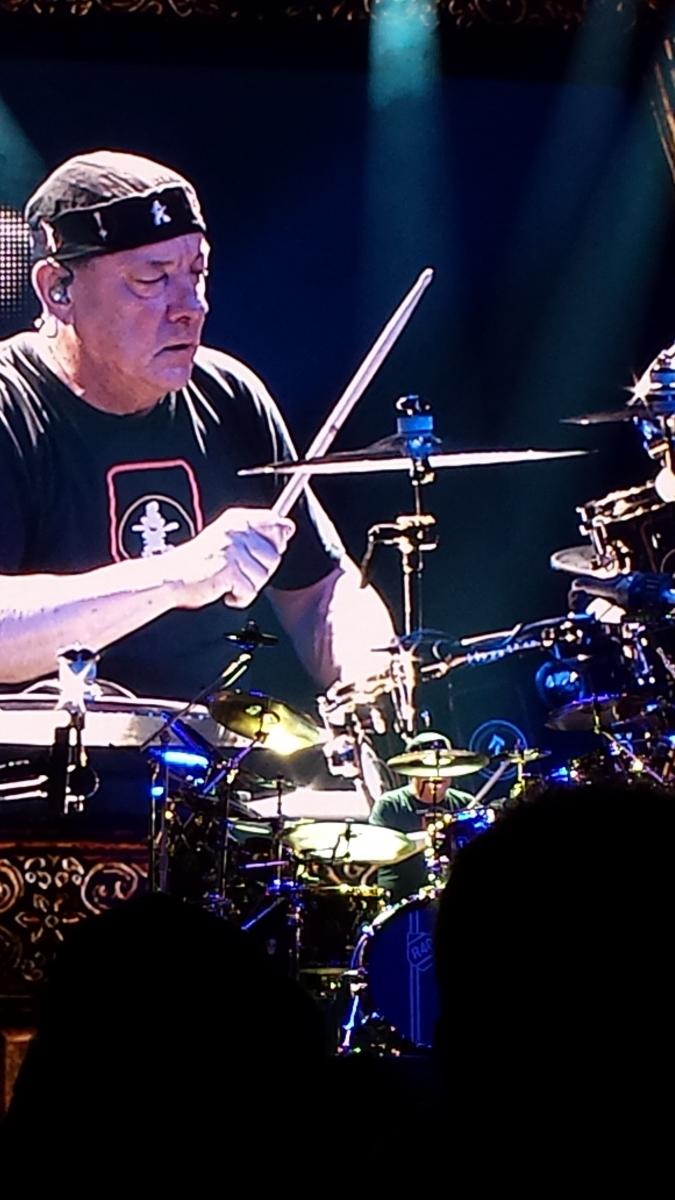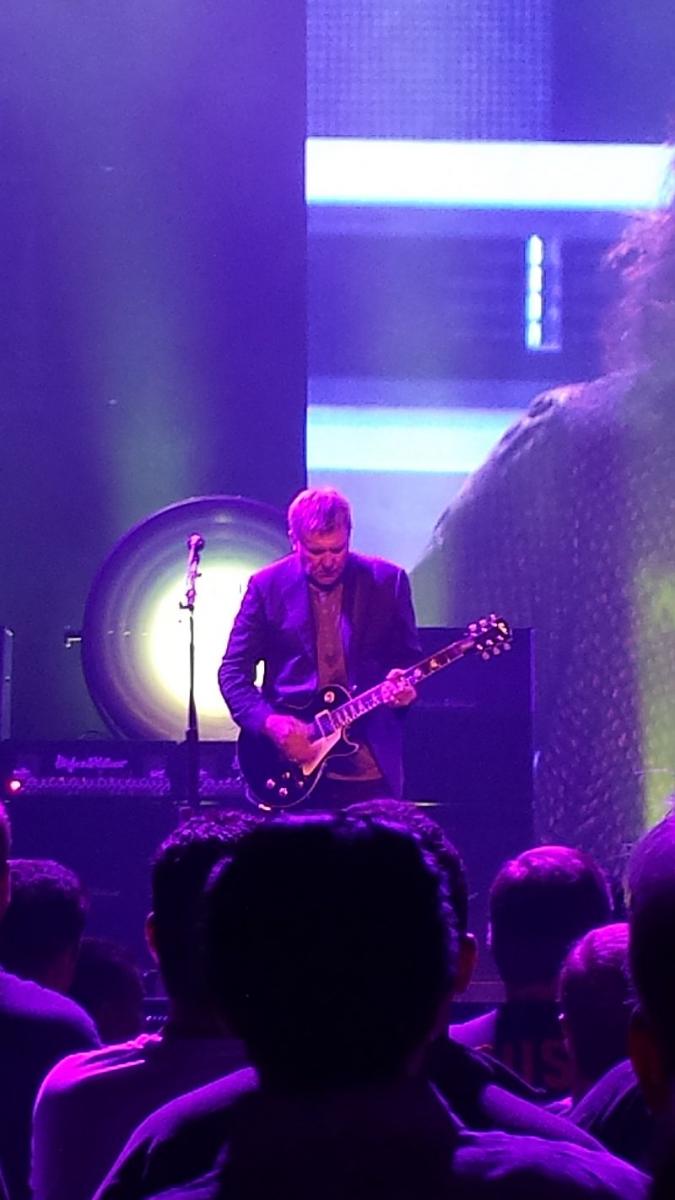Rush's R40 Tour Rocks Scottrade Center
FTC Statement: Reviewers are frequently provided by the publisher/production company with a copy of the material being reviewed.The opinions published are solely those of the respective reviewers and may not reflect the opinions of CriticalBlast.com or its management.
As an Amazon Associate, we earn from qualifying purchases. (This is a legal requirement, as apparently some sites advertise for Amazon for free. Yes, that's sarcasm.)

Geddy Lee, Alex Lifeson and Neil Peart. Three pretty unassuming Canadians fellows who, unlike many high profile celebrities, can often enjoy a peaceful meal without people recognizing them. I don’t know when they arrived in St. Louis for tonight’s gig at the Scottrade Center, but I bet they’re not quite as incognito here as they might be in Denver or Atlanta or Houston. St. Louis is a Rush town. If Sammy Haggar is our musical mayor, Rush is our Board of Aldermen. Kind of makes you think of their hit “Subdivisions” in a whole different way, doesn’t it?
For my money, there is no more precise band in rock & roll than Rush. I’ve seen bands with twice as many members who couldn’t come close to creating the full spectrum of sound that these Rock & Roll Hall of Famers routinely accomplish. Rush defies convention in so many ways—Drummer Neil “the Professor” Peart writes their lyrics but bassist/keyboardist Geddy Lee sings them, and he composes the instrumentation with (in my opinion) underrated guitarist Alex Lifeson. Over the years, Lee’s vocals have retained the higher register but softened the harsh shrillness of his early work that some critics have complained about over the years, likely the same ones who raved about Axel Rose once upon a time. Remember, friends, it’s the quiet, unassuming ones you have to watch out for. Geddy Lee’s mutant-like ability to sing, play base and on occasion play keyboards simultaneously has always impressed me. Peart is an extremely interesting fellow in his own right, and his approach to drumming is worthy of an entire documentary. Rather late in his career he made some sweeping changes in his approach, maintaining the incredible precision he always possessed with more visceral energy, yet on stage he shows very little emotion, reaching a Zen-like state that could perhaps be best described as “Vulcan.” Lifeson, will simply saunter out on stage and rock the tinnitus right out of your skull.

And that’s exactly what Rush did on May 14, 2015 at the Scottrade Center in St. Louis. Sure, it was a Thursday, but when Rush arrives at their home away from Canada it’s unofficially a three day weekend in the Gateway to the West. The R40 Tour is a retrospective of their career, performed in an interesting way: backwards. They started the show with an elaborate stage set-up, featuring visual effects, a great wall of Marshall stacks, Peart’s colossal kit, and various bric-a-brac. They festivities began with “The Anarchist” followed by the title track from 2012’s Clockwork Angels. They performed “Headlong Flight” from that album as well before moving back to 2007’s Snakes and Arrows with “Far Cry,” and “The Main Monkey Business” and then on to 2002’s Vapor Trails with “One Little Victory” followed by “Animate” from 1993’s Counterparts. The title track from 1991’s Roll the Bones was next and I must admit to feeling a very fleeting moment of disappointment that “Ghost of a Chance” and “Dreamline” didn’t make the set list, but heck, they could play an entirely different set the next day and still not cover everything people hope to hear. You don’t reach a 40 year anniversary tour without being pretty prolific. “Distant Early Warning” from 1984’s Grace Under Pressure and “Subdivisions”—one of my favorites—from 1982’s Signals ended the opening set.
It was near the end of the first set when I realized that not only was I hearing the best of rush counted down from newest to oldest, but I was seeing their devolution as well. With each step back in time, the roadies would break down the set little by little. While I was focusing on Peart’s Zen mastery of percussion, the crew would slide off a couple of set pieces, maybe steal away a stack of amplifiers, and perhaps they’d add a different element for a slightly different aesthetic. This continued throughout the performance, leaving the trio to do their encore with only the most basic on-stage set-up. I’ve seen more elaborate staging at local bars for less than 50 people than what Rush finished with in front of a full enthusiastic audience at Scottrade Center. It was a fun ride, and completely unexpected according to the fellow seated next to me who claimed to have seen the band some 60 times previously. I couldn’t help but think how convenient it must me too—the bulk of the set is already packed and waiting to go to the next stop on the tour by the time the current show is over. Pretty sneaky, gents!
The second set started out with the mega popular “Tom Sawyer” and “Red Barchetta” from 1981’s Moving Pictures. No “Limelight” tonight but you can’t have everything (where would you put it?). “The Spirit of Radio” and Jacob’s Ladder” from 1980’s Permanent Waves came next. Man, Rush was cranking out some music in those days, weren’t they? Four albums in five years—one might assume that they spent 1983 on a whirlwind tour or took a much deserved vacation. 1978’s Hemispheres was represented by the “Cygnus X-1” suite rather than by “Trees,” which suited me just fine—if there’s any Rush song that might be overplayed in St. Louis, it’s probably “Trees.” “Closer to the Heart” and “Xanadu,” from Rush’s fifth studio album, 1977’s A Farewell to Kings, which also included more from the “Cygnus X-1” series, was a terrific segment in the show, really showing off the musicianship of each performer separately and collectively. Rush’s time machine next stopped in 1976 with their masterful 2112 album and “The Temples of Syrinx,” which I absolutely love but have often wondered just how such a peculiar song became a huge hit. I can’t think of too many other songs that have such a Robert E. Howard meets Edgar Rice Burroughs feel about them.

The encore consisted of music from Rush’s earliest work. 1975 saw Rush release twin albums, with Caress of Steel dropping late that year—represented here by “Lakeside Park”—and Fly By Night about six months prior, represented by “Anthem.” Their 1974 self-titled debut album brought the show to a close with “What You’re Doing” and “Working Man.” The beginning of the show, the second act and the encore featured short videos, highlighting various points of their careers. The encore video was a send up of the old “American Bandstand” days with Canadian actor Eugene Levy playing the role of a disco era music show host introducing Rush as “a young up and coming trio from Canada who opened a couple of times for KISS.” He also suggested that they add a couple of members, perhaps a horn section, because everybody knows that trios never succeed in the music business (despite copious evidence to the contrary: Cream, later-day Genesis, The Police and Nirvana just off the top of my head—and having typed “top” reminded me of ZZ Top as well). There was also a video coda showing the band barred from their dressing room by a clown dressed as a marionette puppet and the raucous partying of visual elements taken off of their album cover art and animated behind the clown.
Rush’s R40 Tour is an incredible experience for any fan, and Rush diehards will appreciate the little “lost gems” getting some live love over some more popular hits. I encourage their fans to catch the tour if it stops anywhere near you, because rush is likely ending the big 150-date touring schedule they’ve regularly embarked on. Nobody can go on forever, but Rush is far from done. You can probably count on one finger how many bands from the early 1970s sound better 40 years later. Geddy’s voice has mellowed like a fine wine, still hitting surprising notes but without the harshness of his younger vintage, Neil’s drumming is so sublime at times I felt like I was watching a painter completely absorbed by his muse. Alex just hangs out across the stage, nonchalantly playing riffs to old friends in his garage. After all this time, the many albums, the countless tour stops, the accolades and the Hall of Fame, Rush is still humble. They’ll take whatever M&Ms you put in their bowl. They’ll also rock you out of your seat like they first did forty years ago.


